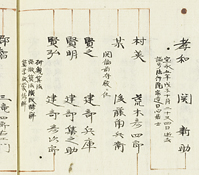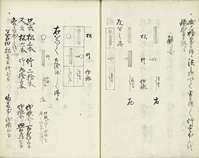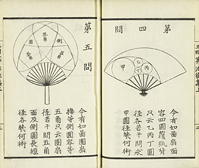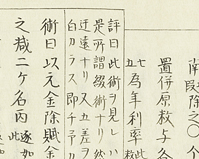Chapter 3. Master Institution - Wasan as a Hobby
(1) Master institution and system
One of the very interesting topics in the cultural aspect of the late Edo period was that the master institutions were organized in many fields of hobbies. In addition to traditional arts such as Sado (the way of tea) or Kado (the way of flower arrangement) that were continued from the Muromachi period, a master institution (or a group of disciples who are led by their master as the group leader) that controlled a group of enthusiasts in other fields such as Haiku and Wasan was established. As the Edo period lacked facilities or organizations such as the modern institutions of higher education and public cultural facilities that we have today, those who loved their own hobbies organized their own private circles, setting a head (master) over the circle and promoting their activities under a pyramidal organization consisting of members, from the master down to the beginners.
In the case of Wasan, a huge number of schools with different masters , small and large, were founded across Japan. The Seki school that looked up to Seki Takakazu (?-1708) as its original master boasted the largest organization in Edo as its hub. From the 1760s, a Wasan scholar called Yamaji Nushizumi (1704-1772) or the fourth disciple counting from Seki Takakazu contributed to establishing the Seki school by absorbing research results accomplished after the demise of Seki. Many disciples gathered around him, and a juku (private school) where disciples would concentrate from across Japan was formed from among them. In the case of the Seki school, many of those with the rank of samurai who came to Edo for sankin-kotai (feudal lord's alternate-year attendance at the shogun's court) from all over Japan joined the juku, which helped to spread it across Japan.
We can imagine such juku schools being operated in many ways. For one thing, there was a juku school where the students first studied introductory arithmetic, and after that proceeded to the next stage where they were presented with mathematical problems and they were instructed to solve the problems presented to them; through such practical exercises they improved their mathematical knowledge. The students gathered at their juku at a predetermined date and time and were divided into two teams: One team would present problems and the other would answer them. The system was such that through the battle of presenting problems and answering them, the teams gained points, and the team with the most points could proceed to the next stage.
Another aspect of the system was that those who gathered at the Wasan schools across Japan enjoyed answering the mathematical problems as if they were solving puzzles. They followed the curriculum that defined the progress stages and their master granted them a certificate of full mastery of the mathematics when the master accepted that they had mastered the mathematics to the required degree. It could be said that their ambition to rise in the school supported the master institute.

Diagram showing mentor-disciple relationships between Wasan scholars
Library of Sugaku sosetsu
Sugaku sosetsu
NDL Digital Collections
Example of an elementary textbook in the Seki school
Library of Hotei ryoshiki
Hotei ryoshiki
NDL Digital Collections
(2) Transmitting their outcome
On the other hand, master institutes always tried to actively send messages beyond the confines of their schools. An example of such activity was the dedication of sangaku (mathematical tablets) to shrines or temples.
Sangaku refers to a tablet in the form of ema (votive wooden tablet with a ridge in the form of a roof on which a horse is painted), in which a mathematical problem and its answer were described, dedicated to an emado (shrine building where votive picture tablets are hanged); and it was established as the method with which the master institute revealed its accomplishments, and posted at major shrines and temples across the country. Mathematical tablet dedication was a handier means of attracting the attention of many people than issuing publications. For this reason, it seems that more conspicuous and complicated geometric problems or garishly painted geometric shapes were selected from the mathematical problems.
In the latter half of the Edo period, bookstores appeared that specialized in publishing books related to mathematics and calendar systems. Suigyoku-do, a bookstore in Kyoto run by Ten'nojiya Ichirobe (mentioned earlier), published many Wasan books by the Seki school and contributed to the diffusion of the school. In the last days of the Tokugawa regime, Hokurin-do in Edo also published many Wasan books by the Seki school. The spread of the Wasan books must have further increased the number of Wasan lovers.
- Column Sangaku (Mathematical Tablet) (Level 0)

A collection of problems enjoyable to look at was released.
Library of Gomei sanpo 2
Gomei sanpo 2
NDL Digital Collections
(3) Diversification
In addition to the private juku, we can find a few examples of clan schools in some powerful feudal domains that started to teach arithmetic in the nineteenth century. The Sendai Domain was leading the trend. Records from the time reveals that at Yoken-do, the clan school of the Sendai Domain, several arithmetic teachers were appointed to instruct some 40 samurai students serving the domain. In the case of the clan schools of the feudal lord domains, it is thought that the mathematics that was taught placed more emphasis on practice and practical science than on play or games.
Speaking of the overabundance of Wasan schools set up around the country, the dispute between the Seki school and the Saijo school that occurred at the end of the eighteenth century stands out as a famous incident. The Saijo school was a Wasan school established in Edo by a Wasan scholar called Aida Yasuaki (1747-1817) from the Dewa district. What caused him to set up the school in the first place was the fact that he had been rejected from entering the Seki school. Looking at the reason now, this seems so trivial that it should hardly constitute a valid reason. Aida himself was not a novice then, and was considering entering the Seki school after he had studied a set of mathematical subjects, and consequently we can imagine that the real reason for his establishing his own school was his wounded pride. Regardless of the reason, a few Wasan scholars in the Seki school and in the Saijo school published a number of mathematical books that criticized their rival and argued over mathematical theories for sentimental reasons. The dispute hardly could be said to have been productive, but it must be a good example of the sense of sectionalism of schools that constituted a kind of a hobby group at that time.

Criticizes solutions included in other books.
Library of Tetsujutsu
Tetsujutsu by Aida Yasuaki
NDL Digital Collections


